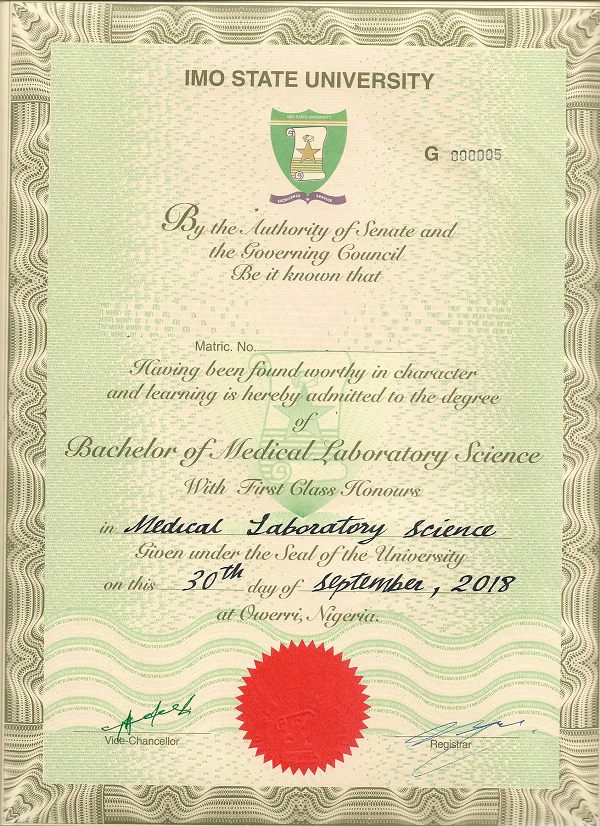Medical Laboratory Science
Evaluation Of The Effect Of Malaria Parasitaemia On Serum Bilirubin In Primary School Children In Owerri
Evaluation Of The Effect Of Malaria Parasitaemia On Serum Bilirubin In Primary School Children In Owerri
ABSTRACT
Malaria is the most important of the parasitic diseases of humans, with over 1 billion cases and between 1-3 million deaths each year, most of whom are children below the age of 5 years. The resultant hemolysis and severe infestation of the RBCs by P. falciparum lead to rise in bilirubin level. The study reported here was designed to evaluate the effect of malaria parasitaemia on serum bilirubin in primary school children in Owerri. This examination was carried out in Owerri, Imo state and was a cross-sectional study of 60 subjects: 30 primarry school children infected with P. falciparum and 30 apparently healthy primary school children. Consent forms as well as questionnaires were distributed and then filled by the subjects. Capillary blood was collected from each of the participants and then Malaria rapid diagnostic test. Blood (5 mL) was collected from each participant into a plain tube and the serum used for serum bilirubin estimation. The result showed that the total bilirubin concentration of malaria infected school children (4.65±1.73) was statistically higher (P<0.05) than that of the non-infected school children (0.69±0.23). In the same vein, the direct bilirubin concentration of malaria infected school children (3.32±2.05) was statistically higher (P<0.05) than that of the control group (0.25±0.15). Both the concentrations of total bilirubin and direct bilirubin increased as the intensity of malaria increased. In other words, the concentration of bilirubin is directly proportional to the intensity of malaria. The findings of this study revealed that abnormal levels of plasma unconjugated bilirubin observed in malaria patients does not conclusively imply liver disease, this could be as a result of P. falciparum induced intravascular haemolysis and it is not all the cases of malaria infections that are associated with derangement of liver functions. However, liver involvement may be dependent on the load of parasitaemia. It is of great importance to know that liver functions should be assessed and impairment should be managed properly in the course of malaria to prevent complications.
CHAPTER ONE
-
INTRODUCTION
Malaria is a parasitic infection that is commonly spread through the bite of Plasmodia infected vector, female Anopheles mosquitoes. Other means of transmitting the infection are through blood transfusion (Strickland, 2010) and congenital transmission (Ezechukwu et al., 2014). Malaria is the most important of the parasitic diseases of humans, with over 1 billion cases and between 1-3 million deaths each year, most of whom are children below the age of 5 years (CDC). There are four different species of Plasmodium that can cause malaria; viz Plasmodium falciparum, P. vivax, P. malariae, and P. ovale. Malaria caused by P. falciparum is the most dangerous form of malaria (Perlmann and Troye-Blomberg, 2010). The largest proportion of this morbidity and mortality occurs in sub-Saharan Africa; in most African countries, 75% of cases were due to P. falciparum, whereas in most other countries with malaria transmission, other less virulent plasmodial species predominate (Snow et al., 2015). Almost every malarial death is caused by P. falciparum (Whitten et al., 2011).
When the parasites reach densities of about 50/μL of blood, the symptomatic stage of the infection begins, which is mainly characterized by headache, fatigue, abdominal discomfort, muscle aches and fever (Nicholas and Joel, 2015). Malaria leads to systemic manifestations with effects on major organs such as kidneys and liver (Chung and Friedman, 2012). There could also be pulmonary complications resulting from malaria infection ((Whitten et al., 2011). Renal impairment is common among adults with severe falciparum malaria but rare among children (Snow et al., 2015). Mild and severe forms of haemolytic jaundice are also common and they are associated with P. falciparum infections however, severe haemolytic jaundice is more common in adults than children, and these result from hemolysis, hepatocyte injury, and cholestasis (Mishra et al., 2013). Malaria as a result of P. falciparum infection causes clinical jaundice (plasma total bilirubin >3mg/dL) in about 2.5 – 5.3% of infections in endemic areas (Anand et al., 2012). A number of histological changes in the liver in P. falciparum malaria which include reactive Kupffer cells, retention of haemozoin pigment and minimal parasitized red blood cell (PRBC) sequestration has been reported. Hepatic involvement in P. falciparum malaria is therefore a common presentation, and presence of jaundice is one of the indicators of severe malaria as defined by World Health Organization in 2008 (Barnwell, 2011).
Jaundice in falciparum malaria may vary from mild to severe and is associated with high incidence of complications and mortality (Murthy et al., 2018). In clinical diagnosis, plasma activities of AST, ALT and ALP are useful diagnostic markers of liver diseases. AST is abundant in the liver, cardiac muscle, skeletal muscle and erythrocytes, relative to ALT (Renze and Mauro, 2018), whereas bilirubin is a breakdown product of haemoglobin metabolism. Since raised plasma activities of AST and elevated plasma level of unconjugated bilirubin could be as a result of haemolysis as well as liver disease (Trefor et al., 2008).
-
JUSTIFICATION
The resultant hemolysis and severe infestation of the RBCs by P. falciparum lead to rise in bilirubin level. Clogging of the capillaries in the important organ is caused by sequestration of the parasite – infested RBCs in the capillaries, which results ischemia and can lead to dysfunctioning of the organ system. When the same happens in the liver, it is called hepatic dysfunction (Nicholas and Joel, 2015). Data on the effect of malaria parasitaemia on serum bilirubin level in primary school children in Owerri could be lacking. Hence the relevance of this project work.
-
AIM AND OBJECTIVES
Aim:
To evaluate the effect of malaria parasitaemia on serum bilirubin in primary school children in Owerri.
Objectives:
- To screen for the presence of malaria parasites in blood samples from primary school children
- To evaluate the levels of serum bilirubin in those infected with malaria parasite
- To compare the level of serum bilirubin in primary school children infected with malaria parasite with that of those not infected.
Pages: 75
Category: Project
Format: Word & PDF
Chapters: 1-5
Material contains Table of Content, Abstract and References
-

 IMSU News4 years ago
IMSU News4 years agoIs It Worth Registering a Pre-degree Program In IMSU? All you need to know about IMSU Pre-degree
-

 IMSU News5 years ago
IMSU News5 years ago7 Popular department in Imo State University (IMSU)
-

 IMSU News2 years ago
IMSU News2 years agoIMSU reprinting for 2023/2024 post UTME candidates has commenced
-

 IMSU News4 years ago
IMSU News4 years agoSteps on How to Apply for Certificate in Imo State University, Owerri (IMSU)

